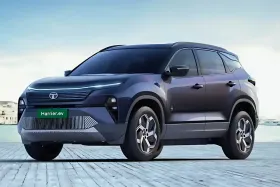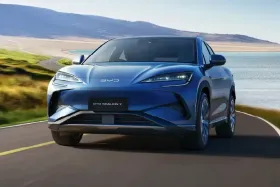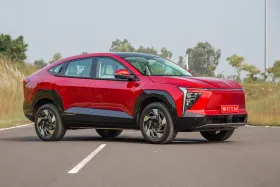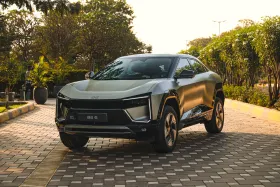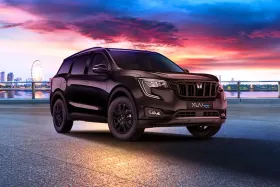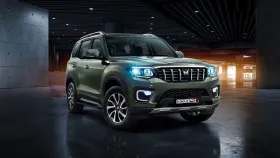TL; DR
- Although the Harrier EV is a rear-biased AWD, with a 234 hp motor on the rear axle, it also features a 155 hp motor on the front axle, sending power to all four wheels for maneuvering on tricky terrains.
- On the Harrier EV, you can set the cruise control to speeds as low as 5 km/h, a feature that eliminates the need for the driver to provide constant throttle and brake inputs.
- The Tata Harrier EV is not only the first car in India, but also the first in the world to feature a 14.53-inch Harman infotainment screen, incorporating Samsung’s Neo QLED technology.
- Along with the usual 360-degree surround camera system, the Harrier EV also features a Transparent Mode, which allows the driver to see what’s beneath their car.
- Yet another feature that isn’t available on an electric SUV under Rs. 30 lakhs is the digital IRVM on the Harrier EV.
Jumping into the futuristic electric SUV bandwagon started by Mahindra, another Indian automaker, Tata Motors has launched the Harrier.ev, also known as the Harrier EV. Instead of the powerful 4-cylinder inline Kryotec 2.0L diesel engine found in the ICE version, the C-segment SUV features a real-world range of around 500 kilometers on a single charge with the 75 kWh battery pack.
Harrier EV: Tata’s New-Age Electric SUV

The Harrier EV can sprint from zero to 100 km/h in 6.3 seconds, making it the fastest Indian SUV (as claimed by the company). To control the raw power, the SUV offers multiple terrain and drive modes for adjusting the amount of power, traction, and regenerative braking. Built on the Acti.ev platform, the Harrier EV comes equipped with numerous safety features, including six standard airbags (seven in higher trims) and an electronic stability program with i-VBAC for enhanced braking control.
You also get features like powered and ventilated front seats, powered BOSS mode, dual-zone climate control, panoramic sunroof, ambient lighting, vehicle-to-load (V2L), vehicle-to-vehicle (V2V), and ADAS Level 2 features that even work at slow speeds. Among all, there are five such features that aren’t available on any other electric SUV under or around the Rs. 30 lakh price range.
Also Read: Tata Harrier EV vs. Competition: Here’s How The New-Age Electric SUV Compares To Its Rivals
First Indigenous Electric SUV To Feature Quad-Wheel Drive Configuration

Even though Mahindra has the first-mover advantage with the new-age SUVs (as it released the BE 6 and the XEV 9e in 2024), it hasn’t equipped its latest models with an all-wheel-drive (AWD) configuration. This is where the Harrier EV has a clear advantage over its direct competitors.
Although the Harrier EV is a rear-biased AWD, with a 234 hp motor on the rear axle, it also features a 155 hp motor on the front axle, sending power to all four wheels for maneuvering on tricky terrains. The total torque outcome, at the same time, is 504 Nm, which, to the best of our knowledge, is the most powerful EV in the price range.
Along with the AWD configuration, the indigenous SUV offers six terrain modes: Normal, Grass/Snow, Mud/Gravel, Sand, Rock Crawl, and Custom. It also offers multiple drive modes, including Boost and Drift.
Harrier EV Features Off-Road Assist With 5 km/h Cruise Control

For the first time in the segment, the Harrier EV features an off-road assist function, which helps the driver maintain an ultra-low yet steady speed while navigating challenging off-road sections, such as steep rocky patches, declines, deep ruts, or narrow passages, where precise wheel placement and controlled pace are crucial.
On the Harrier EV, you can set the cruise control to speeds as low as 5 km/h, a feature that eliminates the need for the driver to provide constant throttle and brake inputs (which might lead to wheel spins or stalling), as well as the intense concentration required. While the ECU handles the off-road-centric cruise control, the driver can focus entirely on the terrain and steering, reducing fatigue and increasing command.

It is worth mentioning that Tata’s flagship EV also features Auto Park Assist (APA), which can automatically park the vehicle in parallel or perpendicular parking spaces, allowing drivers to define custom parking settings. Furthermore, it also features a Summon Mode, which allows you to summon the vehicle in or out of tight spaces. Although these features are available on Mahindra’s new electric SUVs, they aren’t to be ignored.
What’s new (or at least sounds new) is the Reverse Assist feature, wherein the Harrier EV can retrace the exact path in reverse up to the last 50 meters, which could help take drivers out of tight situations where there is no way forward. The effectiveness of this feature, however, is yet to be tested in real-life scenarios.
Also Read: 11 Compact SUVs Under Rs. 10 Lakh (B1 & B2 Segment) In India With Key Features And Specifications
World’s First Vehicle To Feature Samsung’s NEO QLED Screen

Harman Automotive, a subsidiary of Samsung, showcased its new infotainment display at CES 2025. As it turns out, the Tata Harrier EV is not only the first car in India to feature this display technology but also the first in the world. We’re talking about a massive 14.53-inch Harman infotainment screen, which features Samsung’s Neo QLED technology.
The Neo QLED technology features an LCD screen with a mini LED backlighting system that enhances local dimming zones, along with a quantum dot layer that improves color accuracy. Combined, these technologies significantly enhance the screen’s visibility and color reproduction, bringing it closer to the high-quality screens of Samsung televisions.
As seen in the videos of the vehicle, the screen has relatively thinner bezels and a sleek frame, qualities that are often uncommon for infotainment screens. In simpler terms, the difference between an average infotainment screen and the Harrier EV’s Harman automotive screen is akin to the distinction between an average LED TV and a Samsung Neo QLED TV. However, this is something that’s more noticeable in real life than in pictures or videos.
The infotainment system is paired with a set of 10 JBL Black speakers with multiple audio modes and Dolby Atmos.
540-Degree Surround Camera System With A Transparent Mode

Along with the usual 360-degree surround camera system, the Harrier EV also features a Transparent Mode, which allows the driver to see what’s beneath their car. It displays the car’s surroundings on the infotainment screen, accompanied by a transparent image of the car that also shows what’s underneath the vehicle. Basically, it’s a visual feed stitched together from multiple angles.
There are several scenarios where the feature can be useful, including parking in tight spaces and identifying obstacles beneath the vehicle. The car also alerts drivers about any potholes or curbs and helps avoid them. Hence, at any given point, drivers have a good idea about the car’s surroundings, which can help them drive with greater confidence and precision.
Along with the 360-degree camera, Transparent Mode, and blind-spot monitoring, the Harrier EV helps drivers avoid bumping into hidden objects and misjudging tight gaps.
Digital IRVMs With Clear Front And Rear Views

Yet another feature that isn’t available on an electric SUV under Rs. 30 lakhs is the digital IRVM on the Harrier EV. It contains a screen that showcases a clear view of both the rear and the front angles via cameras in the shark-fin antenna and front bumper, respectively. So, even if you have the boot fully loaded to the top, you can easily check the rear view without obstructions.
The integrated cameras also double as a dashcam (with support for up to 128GB of storage). They continuously record footage from the cameras while you’re driving (1920 x 1080 front feed, 1920 x 384 rear feed), which is incredibly useful in the event of an accident or dispute. Users can also transfer the video recording by sharing a QR code on the IRVM screen.
Typically, buyers spend thousands of rupees on purchasing and installing a third-party dashcam on their vehicles; however, integrating it within the IRVM is both efficient and innovative.
India’s First In-Car UPI-Based Payment System

According to Tata’s official press release, its latest electric SUV provides India’s first UPI-based in-car payment system. In theory, you should be able to send charge station payments and FASTag recharges directly from their account to the merchant’s account without having to recharge a wallet and maintain a balance in it. While performing a UPI transaction entails using your smartphone, Tata’s innovation brings bank-to-bank transfers to the car’s infotainment interface. This allows for real-time, wallet-free, and app-free transactions.
Also Read: Skoda Kodiaq vs Rivals: Premium SUV Market Is Hotter Than Ever
You can follow Smartprix on Twitter, Facebook, Instagram, and Google News. Visit smartprix.com for the latest tech and auto news, reviews, and guides.















